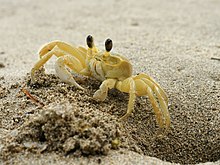Atlantic ghost crab
| Ocypode quadrata Temporal range:
| |
|---|---|

| |
| Adult O. quadrata by a burrow entrance | |
| Scientific classification | |
| Kingdom: | |
| Phylum: | |
| Subphylum: | |
| Class: | |
| Order: | |
| Infraorder: | |
| Family: | |
| Genus: | |
| Species: | O. quadrata
|
| Binomial name | |
| Ocypode quadrata | |
| Synonyms | |
| |
Ocypode quadrata is a species of ghost crab, once described as an "occult, secretive alien from the ancient depths of the sea".[2] It is a common species along the Atlantic coast of the United States, where it is the only species of ghost crab;[3] its range of distribution extends from its northernmost reach on Rhode Island's beaches south along the coasts of the tropical Western Atlantic Ocean to the beach of Barra do Chui, in Rio Grande do Sul in Southern Brazil.[4]
Description
Adults are greyish or the colour of straw, and approximately 5 centimetres (2 in) wide at maturity.[2] They must return to water periodically in order to moisten their gills, and when larvae must be released into the sea, but are otherwise terrestrial.[2] Their stalked compound eyes can swivel to give them 360° vision.[3] Young crabs are cryptically coloured to blend in with their sandy habitat.[3]
Distribution
O. quadrata is found from Block Island, Rhode Island to Santa Catarina, Brazil, on Fernando de Noronha and Bermuda. Its planktonic larvae have been found even further north, at Woods Hole, Massachusetts, although the adults cannot survive there.[2]
Fossil record
Fossil specimens of O. quadrata have been found in rocks dating from the Pleistocene.[5]
Ecology

O. quadrata lives in burrows in sand above the strandline.[3] Older individuals dig their burrows further from the sea, some starting as much as 400 metres (0.25 mi) inland.[2] Burrows can be up to 1.3 metres (4 ft 3 in) deep, and can be closed off with sand during hot periods.[2]
O. quadrata can produce a variety of sounds, by striking the ground with the claw, by stridulation with the legs, and an incompletely explained "bubbling sound".[6] Males compete in a heavily ritualised manner which prevents the need for physical contact.[6]
O. quadrata is more active at night than in the day time, and is an omnivore,[3] eating clams, insects, plant material, detritus and even other crabs.[6]
Sandy beaches, a habitat frequented by ghost crabs, have seen a decrease in the abundance of ghost crabs due to human behovior.[7] Ghost crabs are negatively impacted by human and vehicle trampling which results in direct crushing of crabs as well as indirect damage such as compression of sediment which reduces habitat suitability, interference with reproductive behaviors, reduction in food supply, and light pollution.[8] Consequently O. quadrata is less common on beaches frequented by people.
External links
 Media related to Ocypode quadrata at Wikimedia Commons
Media related to Ocypode quadrata at Wikimedia Commons
References
- ^ Sammy De Grave, N. Dean Pentcheff, Shane T. Ahyong; et al. (2009). "A classification of living and fossil genera of decapod crustaceans" (PDF). Raffles Bulletin of Zoology. Suppl. 21: 1–109.
{{cite journal}}: Explicit use of et al. in:|author=(help)CS1 maint: multiple names: authors list (link) - ^ a b c d e f David Knott. "Atlantic Ghost Crab, Ocypode quadrata" (PDF). South Carolina Department of Natural Resources. Retrieved January 2, 2009.
- ^ a b c d e Jeff S. Pippen (November 12, 2005). "Ghost crab (Ocypode quadrata)". Duke University.
- ^ Adilson Fransozo, Maria Lucia Negreiros-Fransozo & Giovana Bertini (2002). "Morphometric studies of the ghost crab Ocypode quadrata (Fabricius, 1787) (Decapoda: Ocypodidae) from Ubatuba, São Paulo, Brazil". In E. Escobar-Briones & F. Álvarez (ed.). Modern Approaches to the Study of Crustacea. New York: Kluwer/Plenum. pp. 189–195. ISBN 0306473666.
- ^ Roger W. Portell, Richard L. Turner & John L. Beerensson (2003). "Occurrence of the Atlantic ghost crab Ocypode quadrata from the Upper Pleistocene to Holocene Anastasia Formation of Florida". Journal of Crustacean Biology. 23 (3): 712–722. doi:10.1651/C-2340.
- ^ a b c Jeffrey Shields (1998). "The ghost crab, Ocypode quadrata". Virginia Institute of Marine Science. Retrieved January 2, 2010.
- ^ Thomas A. Schlacher, Luke Thompson & Sam Price (2007). "Vehicle versus conservation of invertebrates on sandy beaches: mortalities inflicted by offroad vehicles on ghost crabs". Marine Ecology. 28 (3): 354–367. doi:10.1111/j.1439-0485.2007.00156.x.
- ^ Graziani de Freitas Antunes, Ana Paula Nunes do Amaral, Fabiana Pinto Ribarcki, Elenir de Fátima Wiilland, Denise Maria Zancan, Anapaula Sommer Vinagre (2010). "Seasonal variations in the biochemical composition and reproductive cycle of the ghost crab Ocypode quadrata (Fabricius, 1787) in Southern Brazil". Journal of Experimental Zoology. 313A (5): 280–291. doi:10.1002/jez.593.
{{cite journal}}: CS1 maint: multiple names: authors list (link)
